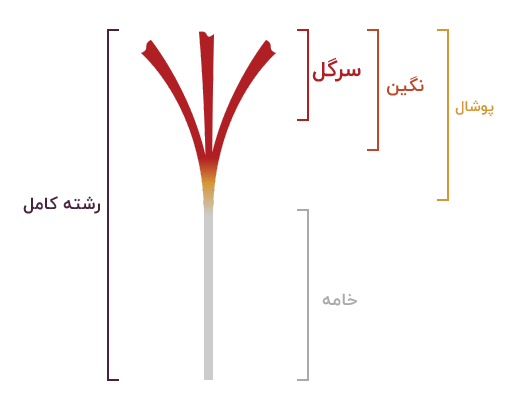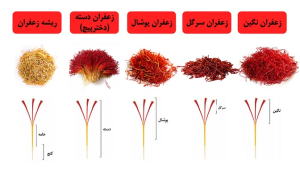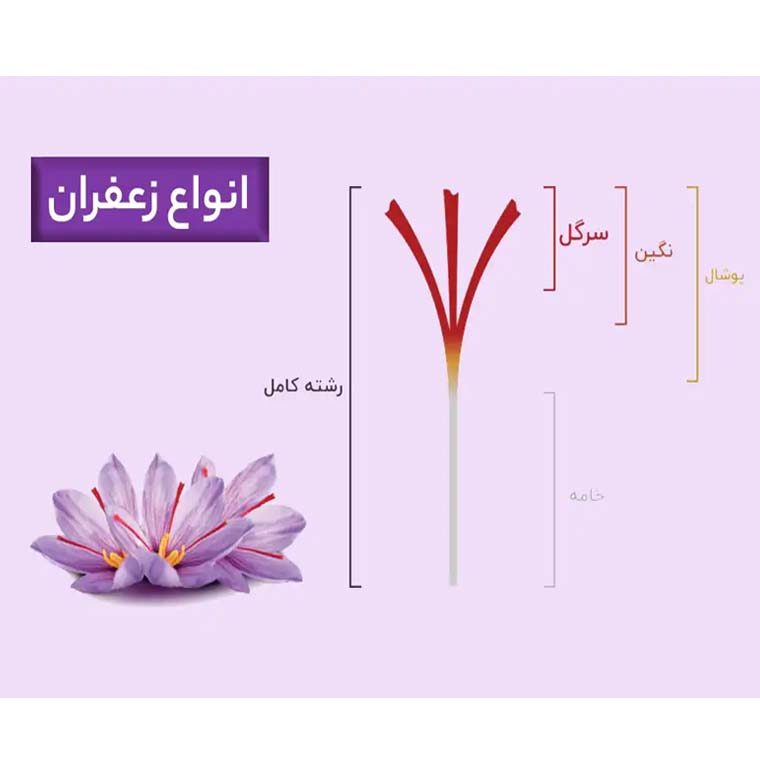To be successful in buying saffron, it is essential to understand the different types of saffron and how to distinguish between them. Before exploring the differences among saffron types, first familiarize yourself with their names:
Types of Saffron:
– Negin Saffron
– Sargol Saffron
– Pushal Saffron
– Dasteh (Daughter) Saffron
– Root Saffron
You might think that different types of saffron come from different flowers or have different cultivation methods, but this is not the case. During the cleaning process, saffron stigmas are cut into various sizes, each with its own specific name. You may wonder what differences in quality and price exist between these types of saffron.

Introduction and Overview of Saffron Types
1. Negin Saffron
Negin saffron consists only of the red parts of the saffron stigma and shows no traces of yellow or white. This type of saffron is valued highly due to its large stigma size and minimal breakage.
Difference Between Negin and Pushal Saffron:*
Negin and Pushal saffron look similar, but Negin saffron is thicker and has a more beautiful appearance. Known for its strong coloring and exceptional aroma, Negin saffron is one of the most expensive types and is primarily used for export.
Characteristics of Negin Saffron:
– No white at the end of the stigma
– No breakage
– Attractive appearance with separate stigmas
Types of Negin Saffron:
– Super Negin: The highest quality saffron, suitable for export to Asian countries.
– Semi-Negin: Lower quality but more affordable, a cost-effective option.
– Negin Grade Two: Medium to high quality, suitable for export.
– Pressed Negin: Compact stigmas, recently popular and suitable for export.
2. Sargol Saffron
Sargol saffron is made from the upper part of the stigma and is sold in small packages for daily use. This type of saffron has high coloring power and aroma, with no yellow or root parts. Compared to Negin saffron, Sargol stigmas are shorter and thinner.
Characteristics of Sargol Saffron:
– Completely separate, red stigmas
– No breakage or stickiness
– More fragments and broken pieces

3. Pushal Saffron
Pushal saffron has red stigmas along with some cream (3 to 5 mm) and is produced early in the harvest season. Since the stigmas are attached to the cream, the likelihood of adulteration is lower.
Characteristics of Pushal Saffron:
– White at the end of the stigma
– Breakage and fragments stuck together
– Attractive color and fibrous threads
4. Dasteh (Daughter) Saffron
Dasteh or Daughter saffron consists of the entire stigma and cream. This type of saffron is popular due to its more affordable price and attractive appearance.
5. Root Saffron
Root saffron is the white part at the end of the stigma, which, contrary to its name, is not found in the soil. This type of saffron has all the properties of saffron but less coloring power and is priced lower.
Summary
This article introduces the different types of saffron and their characteristics. Generally, saffron is categorized into Negin, Pushal, Sargol, Dasteh, and Root varieties.



